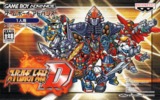The fourth SRT for the GBA brings The Big-O and all the polish of SRT:OG to make it a step ahead of its predecessors.
All Super Robot Taisen(SRT) games share the same basic formula, super robots and real robots from the TV series and movies of the time, with all of their appropriate attacks and abilities, put together in one strategy RPG(SRPG) with a loose story tying them together. So if you are familiar with SRT, or if you like SRPGs then you should have a pretty good idea of what to expect. You command a set number of units, which you usually get to choose, through a number of missions which take place on 2D maps that are laid out on a grid. Through the course of the game you earn credits that you then apply to upgrading the stats and weapons of the robots you like, making them stronger in preparation for the end game. Standard SRPG stuff, just with robots and giant monsters instead of goblins and knights. The main SRT games differ from the OG games because the robots and characters included in them are taken from Japanese Anime as well as including the original robots and characters that appear in the OG games exclusively. If you would like to learn more about SRT and the various robots and characters included in this and other games in the series, go to this link;
http://en.wikipedia.org/wiki/Super_robot_taisen
Super Robot Taisen: Destiny (SRT:D) is the fourth iteration of SRT to appear on the GBA. It takes all the refinements of SRT:OG and brings them to the SRT series proper. SRT:D also represents, in my opinion, one of the better rosters in SRT. The Big-O, Getter Robo: Armageddon, and Macross 7 being new series that I was particularly happy to see included. And while some don't like the original mecha designs for this game, I thought Forte Gigas was great.
The gameplay in SRT:D has seen a number of improvements over SRT:R, and incorporates a lot of the refinements from SRT:OG. For instance, support attack and defense are present, and work as they did in SRT:OG, as do multiple unit combination attacks. New to the series are "chain" or combo attack weapons. Weapons marked with a "C" have the ability to hit up to three enemies that are in a straight line. This gives the player another option in addition to map attacks to take out multiple enemies. With the addition of Macross 7 to the roster comes the song system. The Protodeviln enemies form this series take only 1/2 damage from conventional weapons, but the song energy weapons of the Macross 7 Fire Bomber mecha deal normal and sometimes extra damage to these enemies, in addition to providing stat bonuses to allies. Another great addition to gameplay for SRT:D is tsumesuparobo. This is a kind of training/puzzle challenge mode, where the player is presented with a map with certain enemies, limitations to player units, and specific victory conditions. Playing through these missions will expose the player to different strategic situations, as well as provide the player with extra cash with which to upgrade units for the game proper. And this extra cash comes in very handy because of the final change to SRT:D, the difficulty. One of the main gripes with the GBA iterations of SRT is that they have been too easy, such is no longer the case. SRT:D is much more difficult than its predecessors. This extends to the point where if the player is not diligent in their preparations for battle the game can be punishingly difficult. This is not necessarily a bad thing, and is a wake up call to SRT strategists who have been breezing through the GBA iterations. I found the increased difficulty refreshing, imparting a much greater feeling of satisfaction upon beating the game.
The graphics of SRT:D are identical to those of SRT:OG. That is to say everything is slightly upgraded from SRT:R, with one big addition, animation. SRT:A and R had very limited animation of the unit sprites. Most attacks consisted of the unit sliding across the stage and simply banging into the enemy, or a beam emanating from some apparent weapon, with some slight graphical flash to suggest the appropriate attack. Having followed SRT:OG, SRT:D adds in full animations of the unit sprites. These animations are simple in comparison to the later games in the franchise. However, the added animations combined with some limited anime cut-ins give SRT:D a far more animated presentation than SRT:A or R.
The sound is also improved from SRT:A and R. The themes sound more accurate, and there is more variety to the effects.
The value of SRT:D far exceeds its predecessors. First of all there are two characters and four original mecha to choose from. This combined with a full replay system, in which all money and upgrades carry over to subsequent playthroughs, makes playing the game more than once much more attractive than in the preceding iterations. Also there is a nice touch during the credits that is worth mentioning. While the credits roll the unit sprites and statistics of the mecha used by the player are displayed in order of most to least used. This is just a nice touch that gives the player some insight into how they played through the game. I think this should be implemented in more SRT titles.
Overall SRT:D is a great improvement over SRT:A and R. All the improvements and the great roster choices add up to a great game for any SRT enthusiast or collector. If you are one of these, get it. If you are an SRPG fan and are looking for some robot action on the GBA, this is a good game. However, if you are looking for the best SRT on the GBA, you had better look at the follow up to this game.

